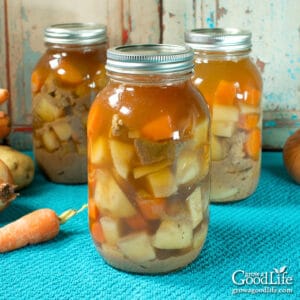
Canning Beef Stew
Home canned beef stew is a hearty and filling meal that can be enjoyed year-round. This recipe and tutorial will teach you how to pressure can beef stew with ease.
Ingredients
- 5 pounds beef stew meat cut into 1 1/2-inch cubes
- 1 tablespoon extra virgin olive oil
- 1 teaspoon canning salt
- 1/2 teaspoon ground black pepper
- 12 cups cubed peeled potatoes about 18 medium or 6 pounds
- 8 cups sliced peeled carrots about 10 medium or 3 pounds
- 3 cups chopped celery about 6 stalks
- 3 cups chopped onions about 4 medium or 1 pound
- 1 teaspoon dried thyme
- 4 quarts beef stock 12 cups
Instructions
Prepare the Canning Equipment:
- Wash the jars, lids, and rings in hot soapy water and rinse thoroughly. Set the lids and rings aside until you are ready to use them.
- Place the jar rack into the pressure canner, and fill with water per your pressure canner manufacturer's instructions: Presto is 3 quarts, Mirro is 2 quarts, and All American is 2 to 3 inches.
- Fill the jars halfway with hot water, and then place them on the rack in the canner. Bring the canner to a simmer for 10 minutes (180˚F). Keep hot until you are ready to fill them.
Make the Beef Stew
- Season the beef cubes with salt and pepper and either toss with oil and brown in a 350˚F oven for about 20 minutes, or sear in oil in a skillet.
- Add the seared beef, prepared potatoes, carrots, celery, onions, thyme, to the pot, and top off with just enough beef stock to cover.
- Stir to combine, and bring the stew to a boil over medium-high heat, and then reduce the heat and simmer (180˚F) for 5 minutes.
Can the Stew
- Spread a kitchen towel on the counter. Use your jar lifter to remove a jar from the canner. Pour out the water (save it for washing dishes), and place the jar on the towel. Keep the remaining jars in the canner, so they stay hot.
- Use the ladle and canning funnel and fill the jar with the stew leaving a 1-inch headspace.
- Run the bubble popper through the jar to release air bubbles, adjust headspace if needed, wipe the rim, and center a lid on the jar, and screw on band until it is fingertip tight.
- Place the jar back into the canner, and repeat with the remaining jars until your canner is full, or you run out of stew.
- Cover the pressure canner and secure the lid. Leave the vent open, adjust the heat to medium-high, and bring the canner to a boil. Allow the pressure canner to vent steam for 10 minutes, then place weight on the vent.
- Once the canner has reached the correct pressure (10 pounds for weighted gauge, and 11 pounds for dial-gauge pressure canner), set a timer, and process quarts for 90 minutes, and pints for 75 minutes at altitudes of less than 1,000 ft. Adjust pressure for your altitude if necessary (see note below). Regulate the heat as needed to maintain a steady pressure.
- When processing time is complete, turn off the heat and let the pressure canner cool and depressurize. The time will depend on your brand and should be between 30 to 60 minutes. Follow the instructions for your pressure canner.
- Once the pressure canner is depressurized, spread a kitchen towel on the counter, remove the weight from the vent pipe or open the petcock, and wait 10 minutes for the jars to adjust to the change in pressure.
- While wearing pot holders, unlock the cover and remove the lid while tilting it away from you so that steam does not burn your face. Allow another 10 minutes for the jars to adjust to the change in pressure.
- Use a jar lifter to remove the jars from canner and place on the towel. Keep the jars upright, and don't tighten bands or check the seals yet. The jars will be bubbling. Let the hot jars sit undisturbed for 12 to 24-hours to cool.
- Wait until the jars have cooled for at least 12-hours, and then check to be sure jar lids have sealed. Test the seal by pushing on the center of the lid. The lid should not pop up. If the lid flexes up and down, it did not seal. Refrigerate the jar and use up within a few days.
- Remove the screw on bands and wash the jars. Label, date, store the jars in a cool, dark place (50 to 70 degrees F). Use within a year for the best quality. Yields about 14 pint jars, or 7 quarts.
Notes
This is a tested safe canning recipe from the Ball Blue Book Guide to Preserving and the Ball Complete Book of Home Preserving. Changing the recipe may make it unsafe for canning.
Pressure adjustments must be made for the type of canner you are using, and for altitudes greater than 1,000 ft (see table below).
I am happy to answer any questions, but if you need immediate canning help or answers, please contact your local extension office.
Nutrition
Serving: 1cupCalories: 260kcalCarbohydrates: 22gProtein: 25gFat: 6gSaturated Fat: 2gCholesterol: 72mgSodium: 630mgPotassium: 1004mgFiber: 4gSugar: 4gCalcium: 43mgIron: 16mg
Tried this recipe?Let us know how it was!